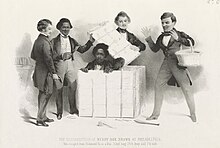Menneskelig post

Menneskelig post er transport af en person via postvæsenet, som regel som en blind passager. Selvom det er sjældent, har der været nogle rapporterede tilfælde af mennesker, der forsøger at rejse via post.
Mere almindeligt, i det mindste i populærfiktion, er forsendelsen af dele af en person, ofte et kidnapningsoffer.
Virkelige hændelser
- Henry Box Brown (alder 42), en afrikansk-amerikansk slave fra Virginia, undslap i en forsendelseskasse sendt nordpå til den frie stat Pennsylvania i 1849. Han blev derefter kendt som Henry "Box" Brown.[1]
- W. Reginald Bray sendte sig selv med posten i England, som almindelig post i 1900 og derefter som anbefalet post i 1903.[2]
- Suffragetterne Elspeth Douglas McClelland og Daisy Solomon sendte sig selv til den daværende premierminister i Storbritannien, H.H. Asquith på 10 Downing Street den 23. februar 1909.[3]
- Reg Spiers 1964, sendte sig selv fra Heathrow Lufthavn i London til Perth Airport i Western Australia. Hans 63-timers rejse foregik i en kasse fremstillet af den britiske spydkaster John McSorley.[4][5]
- Charles McKinley (alder 25) sendte sig selv fra New York til Dallas, Texas i en kasse i 2003. Han forsøgte at besøge sine forældre og ønskede at spare flybilletprisen. Men han blev opdaget under den sidste del af sin rejse.[6]
Børn med posten
Postforsendelse af mennesker, der vejer mindre end 22 kg (50 pounds), dvs. børn, som postpakke i USA var lovlig i årene 1913 og 1914.[7][8][9][10][11]
Noter
- ^ "Henry Box Brown, b. 1816". the University Library, The University of North Carolina at Chapel Hill (engelsk). 2015. Hentet 2015-07-05.
- ^ Foley Mendelssohn, Deirdre (2010-09-14), "The Eccentric Englishman", The New Yorker
- ^ "Human Letters to Downing Street". Museum of London. 2017. Hentet 2017-03-17.
- ^ McSorley: Out Of The Box: The Highs and Lows of a Champion Smuggler. Roaring Forties Press. 2014 ISBN 978-1-938901-32-4
- ^ Spiers, Reg (10. november 1964). "Human air Freight Ticketed With Luck In Trip 'Down Under'". Toledo Blade. s. 1 – via Google Newspapers.
- ^ Hannaford, Alex (2004-08-29), "The crate escape", The Guardian
- ^ "The Cover Story" (PDF). centralfloridastampclub.org (engelsk). 2015. Arkiveret fra originalen (PDF) 23. september 2015. Hentet 2015-07-05.
- ^ "Photograph of letter carrier with child in mailbag". Smithsonian National Postal Museum (engelsk). 2015. Arkiveret fra originalen 5. juli 2015. Hentet 2015-07-05.
- ^ "Very Special Deliveries". Smithsonian National Postal Museum (engelsk). 19. februar 2013. Hentet 2015-07-05.
- ^ "The Atlantic Revisits Sending Babies Through the Mail". smithsonianmag.com (engelsk). 28. juni 2012. Hentet 2015-07-05.
- ^ "Sending Children by Parcel Post". history1900s.about.com (engelsk). 2015. Arkiveret fra originalen 6. september 2015. Hentet 2015-07-05.
Medier brugt på denne side
Title: The resurrection of Henry Box Brown at Philadelphia, who escaped from Richmond Va. in a bx 3 feet long 2 1/2 ft. deep and 2 ft wide
Abstract: A somewhat comic yet sympathetic portrayal of the culminating episode in the flight of slave Henry Brown "who escaped from Richmond Va. in a Box 3 feet long, 2-1/2 ft. deep and 2 ft. wide." In the office of the Pennsylvania Anti-Slavery Society, the young Brown emerges from a crate as several figures, including Frederick Douglass (holding a claw hammer at left) look on. Details of Brown's escape, whereby he had himself shipped via Adams Express from Richmond to Philadelphia, were widely publicized in a narrative of his ordeal published under his own name in 1849. The box itself became an abolitionist metaphor for the inhumanity and spiritual suffocation of slavery. It is shown on an undated broadside published in Boston (Library of Congress, Rare Book and Special Collections Division, Broadside Collection, portfolio 65, no. 16). Physical description: 1 print on wove paper : lithograph ; image 27 x 40 cm., sheet 34.7 x 45.2 cm.
Notes: The Library's impression of the print was deposited for copyright on January 10, 1850.; Title from print.; A similar lithograph with the same title, giving a slightly different version of the scene, was drawn on stone by Peter Kramer and printed by Thomas Sinclair of Philadelphia. (An impression is in the collection of the Library Company of Philadelphia.); "Entered ... 1850 by Henry Box Brown ... District Court of Massachusetts."; Published in: American political prints, 1766-1876 / Bernard F. Reilly. Boston : G.K. Hall, 1991, entry 1850-4.